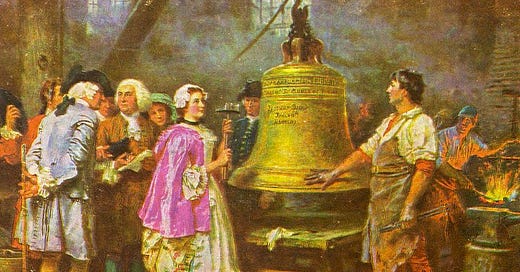TDIH: History of the Liberty Bell
Do you know why it has a crack in it and how they tried to fix it?
On this day in 1776, the Declaration of Independence is formally read in public for the first time. Philadelphia’s city bells toll, gathering people for the event.
The most famous of Philadelphia’s bells is the Liberty Bell, of course. Do you know the story of that iconic bell and why it has a crack in it?
The bell was first commissioned for Philadelphia’s state house in 1751. At the time, the Speaker of the Assembly specifically requested that the bell be inscribed with a Bible verse: “Proclaim Liberty thro’ all the Land to all the Inhabitants thereof” (Leviticus 25:10). The verse seemed appropriate because Pennsylvania was celebrating the 50th year of its Charter of Privileges. That charter had given the people greater ability to rule themselves through their legislature.
The people were excited! Back then, a bell was an important part of town life. It could be used to toll news of anything—a fire, a celebration, or a funeral. Better yet, this bell had been cast by a master founder in England: Thomas Lester of Whitechapel Bell Foundry.
You have to wonder what people thought when the bell was hung and tested for the first time. Can you believe that the bell cracked on its very first use?
Whitechapel gives this explanation: “Good bell metal is extremely brittle . . . . If a bell is struck and not allowed to ring freely, because either the clapper or some part of the frame or fittings are in contact with the bell, then a crack can very easily develop.”
Hmm. The crack in the bell could be due to “user error”?!
Either way, the bell could not be returned, so two local founders attempted to recast it. They added more copper, believing it would make the bell less brittle. Sadly, they added too much copper and ruined the pure tone of the bell. So they tried again, this time adding more tin. Apparently, the second recasting didn’t really help, either. The tone of the bell was still flat.
Nevertheless, the bell was used for years. It hung in the steeple at the state house and tolled many major events. At least according to legend, it tolled on July 8, 1776, when the Declaration of Independence was read publicly in Philadelphia, although the Independence Hall Association notes that the State Hall steeple was in bad condition and might have been under repair that day.
In 1777, the bell was evacuated from the city and hidden under floorboards in a church basement in Allentown. The British were coming and locals feared that the bell would be captured, melted down, and used to make musket balls. The bell was returned to Philadelphia when the British finally evacuated the city in June 1778. Thus, the bell may have tolled, once again, in celebration of Cornwallis’s surrender in 1781.
The crack in the bell today was not present during any of these historic events. So how did that crack happen?
There are many theories. The crack may have begun in July 1835, as Chief Justice John Marshall’s death was being tolled. Either way, the crack seems to have become significantly worse when the bell was rung on Washington’s birthday in 1846.
Obviously, the bell couldn’t be used anymore. Instead, it traveled around the country in the late 1800s and early 1900s. Today, it is kept in the Liberty Bell Center in Independence National Historical Park.
If you haven’t yet seen the bell, it is well worth the visit. ;)
Sources can always be found on my website, here.





Sorry to be late. I must have glitched. I scheduled it for p.m. instead of a.m. LOL. I just noticed what happened and posted it manually. My bad!
I'm glad to remember a Bible verse is on the Liberty Bell.